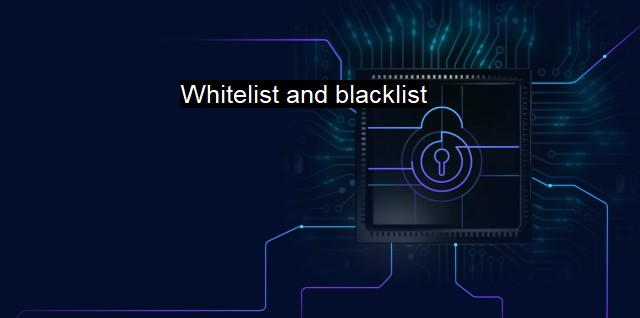What is Whitelist and blacklist?
Protecting Sensitive Information and Devices: The Importance of Whitelisting in Cybersecurity and Antivirus Software
Whitelist and blacklist are two important concepts in the realm of cybersecurity and antivirus software. Although they are contrasting concepts, both play significant roles in improving and maintaining internet security, data protection, and privacy.Simply put, a whitelist is a defined list of items that are granted authorisation or permission. a whitelist refers to a list of IP addresses, email addresses, users, websites, programs, or applications that are acknowledged as safe and trusted. Whitelisting ensures that only items present on this designated list can interact with your system or network, thus offering an optimal level of protection against potentially malicious intruders.
Contrary to the idea of a whitelist, a blacklist is a directory of items that are denied permission or authorisation. this refers to a compilation of known threats from the internet, such as spam emails or malicious IP addresses or websites identified as harmful. Items found on the blacklist are automatically blocked or omitted from interacting with your system or network, offering significant protection against harmful breaches, viruses, or malware attacks.
Antivirus software often includes whitelisting and blacklisting functions to protect your systems. For instance, it may include a whitelist feature that allows only identified, friendly programs to run on your system whilst blocking all others by default. Among its many features, whitelisting can be useful when setting up systems that require substantial protection, like servers. Indeed, servers are intended to run a limited, known set of applications. In that instance, whitelisting is usually more efficient as it minimises excess traffic and granting unnecessary permissions to unknown applications is prevented, thus enhancing the security of the server.
On the other hand, a blacklist present in antivirus software effectively wards off identified potentially harmful elements from infiltrating and infecting a system or network. Blacklists are commonly used to prevent spam emails, block harmful websites, ban certain IP addresses, and halt malicious programs, among others. The blacklist is consistently updated to accommodate emerging threats which enhances its utility.
Utilising both a whitelist and blacklist is a sound cybersecurity strategy. An organization can permit operations from validated users, servers, or applications while simultaneously blocking identified potential threats through the curated blacklist. despite the benefits proffered by whitelists and blacklists, the challenge lies in updating, managing, and ensuring their responsiveness to the ever-evolving landscape of cybersecurity threats.
Continuous updates of the whitelist and blacklist are paramount for their effectiveness as cyber threats are constantly developing. the task of initially and continuously identifying which items should be whitelisted can be arduous. There is always the risk of whitelisting malicious software that disguises itself as a reliable program. Equally taxing is maintaining an up-to-date blacklist as new threats emerge daily.
The complexities attached to whitelisting and blacklisting make antivirus software an incredibly beneficial tool for both individuals and companies. Despite these difficulties, both strategies are integral in the prevention of security breaches by effectively permitting access to trusted sources while denying access or interaction with usually harmful ones. Used properly, the practices of whitelisting and blacklisting significantly keep an organization's or individual's digital assets secured and protected. While they are not foolproof methods, they still are critical components of a comprehensive cybersecurity infrastructure.

Whitelist and blacklist FAQs
What is a whitelist in cybersecurity?
A whitelist is a collection of approved applications, devices, or IP addresses that are considered safe and allowed to access a system or network.What is a blacklist in cybersecurity?
A blacklist is a list of prohibited applications, devices, or IP addresses that are considered unsafe and are blocked from accessing a system or network.What are the benefits of using a whitelist in antivirus software?
Using a whitelist in antivirus software provides a higher level of security because only authorized programs are allowed to run. This can prevent malware and other malicious software from infecting the system.What are the limitations of using a blacklist in antivirus software?
Using a blacklist in antivirus software can be limiting because it only blocks known threats. This means that new malware or unknown threats may not be detected or stopped. Additionally, false positives can often occur, leading to non-malicious applications being blocked.| | A | | | B | | | C | | | D | | | E | | | F | | | G | | | H | | | I | | | J | | | K | | | L | | | M | |
| | N | | | O | | | P | | | Q | | | R | | | S | | | T | | | U | | | V | | | W | | | X | | | Y | | | Z | |
| | 1 | | | 2 | | | 3 | | | 4 | | | 7 | | | 8 | | |||||||